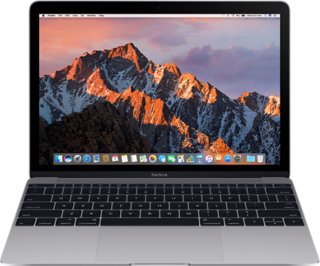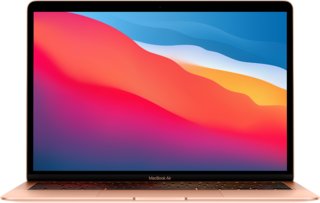Apple MacBook (2016) vs Apple MacBook Air (2020) 13.3" Apple M1
Ready for a friendly comparison between two of Apple's finest: the classic MacBook (2016) and the high-tech MacBook Air (2020)? This article is your guide. Here, we simplify their features, making it easy to see which one is your perfect fit. Is it the tried-and-true MacBook or the latest MacBook Air boasting a powerful M1 chip and expanded RAM? We're about to find out! Each has its own strengths, and choosing one depends on what aligns best with your individual tech needs. So, buckle up and let's dive in!
System and application performance
Performance in popular 3D games
Viewing angle, color accuracy...
Ports, webcam and other interfaces
Potential battery life
Materials, durability and portability
Design Comparison
Size Comparison
Enhancing User Experience: Apple MacBook (2016) vs. Apple MacBook Air (2020)
Ergonomics
- Apple MacBook (2016):
- The compact and lightweight design ensures easy portability for students and professionals who are always on the move.
- The backlit keyboard enables comfortable typing in low-light settings.
- The absence of a fan enhances quiet operation, ideal for quiet environments.
- Apple MacBook Air (2020):
- Slightly larger footprint provides more comfortable typing experience with better palm support.
- Backlit keyboard remains user-friendly in dimly lit settings.
- Fanless design ensures silent operation, eliminating distractions during work or study sessions.
Materials & Build Quality
- Both Models:
- Apple's premium build quality embodies durability and lasting value.
- Aluminum construction provides a sleek and modern appearance, ensuring durable protection from daily usage.
Portability
- Apple MacBook (2016):
- Weighing just over two pounds, it's highly portable for frequent travelers or commuters.
- Apple MacBook Air (2020):
- Slightly heavier than its predecessor but still impressively light at 2.8 pounds, balancing portability with a larger screen size for enhanced productivity.
Unique Design Features
- Apple MacBook Air (2020):
- Thunderbolt 3 ports offer flexible connectivity for external displays, storage devices, and peripherals.
- The fingerprint scanner boosts security and convenience for swift logins and secure transactions.
- Dolby Atmos support enhances audio immersion for entertainment and video conferencing.
Practical Usability & Aesthetic Appeal
- Students: The Apple MacBook (2016) features a compact design, making it perfect for students who need to move between classes or study sessions.
- The larger screen size of the Apple MacBook Air (2020) provides enhanced visibility for research, multimedia projects, and collaborative work.
- Professionals:
- Both models offer professional aesthetics suitable for business settings or client meetings.
- The advanced connectivity options on the Apple MacBook Air (2020) cater to professional demands for efficient multitasking and external device integration.
Conclusion
In conclusion, the Apple MacBook (2016) stands out for extreme portability with its compact design, while the Apple MacBook Air (2020) offers a blend of portability and productivity features. Students may favor the former for its lightweight build, while professionals might lean towards the latter due to its advanced connectivity options and expanded screen real estate.
Screen Comparison
| Apple MacBook (2016) | Apple MacBook Air (2020) 13.3" Apple M1 | |
|---|---|---|
| Refresh Rate | 60 hz | 60 hz |
| Resolution | Full HD | QHD |
| Screen Size | 12" | 13.3" |
When we compare the screen features of the Apple MacBook (2016) and the Apple MacBook Air (2020) 13.3", significant differences emerge that can significantly affect user experience, particularly for activities such as gaming or professional graphic design. Let's explore how these aspects measure up against each other.
Screen Size:
- Apple MacBook (2016): 12 inches
- Apple MacBook Air (2020): 13.3-inch display
Impact: The larger screen size of the Apple MacBook Air provides ample workspace for multitasking and working on graphic design projects with improved clarity and detail, surpassing the smaller screen of the Apple MacBook (2016).
Screen Resolution:
- Apple MacBook (2016): 2304 x 1080 px
- Apple MacBook Air (2020): 2560 x 1440 px
Impact: The Apple MacBook Air's higher resolution delivers sharper images and text, enhancing visual quality for activities such as photo editing or gaming that demand precise details. This results in a more immersive and detailed viewing experience than what the Apple MacBook (2016) with lower resolution can provide.
Pixel Density:
- Apple MacBook (2016): 226 ppi
- Apple MacBook Air (2020): 227 ppi
Impact: Although the naked eye may not detect the slight variance in pixel density, it plays a crucial role in enhancing image sharpness and clarity. Both laptops boast high pixel density, guaranteeing smooth and refined visuals.
Display Technology:
- Both laptops: IPS, LCD, LED-backlit
Impact: The shared display technology ensures consistent color accuracy and wide viewing angles on both laptops, making them suitable for tasks where color precision is essential, such as graphic design work that demands accurate color representation.
Brightness:
- Apple MacBook (2016): 387 nits
- Apple MacBook Air (2020): 400 nits
Impact: The Apple MacBook Air's higher brightness level provides improved visibility under bright lighting conditions, enhancing your viewing experience when working outdoors or in well-lit environments compared to the slightly lower brightness of the Apple MacBook (2016).
Refresh Rate:
- Both laptops: 60 Hz
Impact: Both laptops offer a standard 60 Hz refresh rate, ensuring smooth motion transitions for gaming and video viewing. Competitive gamers may benefit from a higher refresh rate, but these laptops are well-suited for everyday multimedia use.
Conclusion:
The Apple MacBook Air (2020) surpasses the older Apple MacBook (2016) in screen size, resolution, brightness, and pixel density.
- The Apple MacBook Air stands out as a top choice for tasks that demand precise visuals, like professional graphic design and immersive gaming due to its superior screen specifications. In conclusion, if you value a larger screen with better resolution and brightness for activities such as graphic design or gaming, choosing the Apple MacBook Air (2020) over the Apple MacBook (2016) would provide a more satisfying visual experience.
Hardware Comparison
| Apple MacBook (2016) | Apple MacBook Air (2020) 13.3" Apple M1 | |
|---|---|---|
| RAM | 8GB | 8GB |
| Storage Size | 512GB | 512GB |
Comparing the hardware of the Apple MacBook (2016) with the Apple MacBook Air (2020) 13.3" featuring the Apple M1 chip, 8GB RAM, and 512GB SSD reveals crucial factors that can greatly influence performance across different applications.
CPU:
- Apple MacBook (2016): The 2016 MacBook comes equipped with a 2GHz CPU boasting 4 threads.
- MacBook Air (2020): The MacBook Air (2020) features the innovative Apple M1 chip, boasting a speed of 4GHz and 8 threads.
GPU:
- Apple MacBook (2016): The 2016 model does not specify its graphics processing unit.
- MacBook Air (2020): The MacBook Air (2020) features integrated graphics powered by the M1 chip, delivering smooth performance for multimedia activities and casual gaming.
RAM:
- Apple MacBook (2016): Features 8GB RAM running at 1866MHz.
- MacBook Air (2020): With 8GB of RAM clocked at 4266MHz, enabling faster data access for enhanced multitasking performance.
Storage:
- Both laptops come with substantial storage options offering users ample space for their files and applications.
Semiconductor Size:
- Apple MacBook (2016): Features a semiconductor size of 14nm.
- MacBook Air (2020): Boasts a cutting-edge semiconductor size of only 5nm, contributing to better power efficiency and overall performance.
Maximum Memory Amount:
- Apple MacBook (2016): Maximum memory supported is up to 8GB.
- MacBook Air (2020): Supports up to double the memory amount at 16GB, improving its performance for demanding tasks.
Practical Application Impact:
The upgraded components in the MacBook Air (2020), such as the Apple M1 chip, faster RAM speed, enhanced GPU performance, and smaller semiconductor size result in superior performance across various practical applications compared to the older MacBook from 2016. Users can expect smoother multitasking, better graphics rendering for multimedia tasks, and improved efficiency when running heavier software programs on the newer model.
In conclusion, if you prioritize enhanced performance for tasks like photo or video editing, graphic design work, or even light gaming while benefiting from improved power efficiency and future-proofing your investment, the Apple MacBook Air from 2020 with its advanced hardware specifications would be a more suitable choice compared to the older Apple MacBook from 2016.
Battery Comparison
| Apple MacBook (2016) | Apple MacBook Air (2020) 13.3" Apple M1 | |
|---|---|---|
| Battery Life | 11 hours | 18 hours |
When we compare the battery life of the Apple MacBook (2016) and the Apple MacBook Air (2020) 13.3" equipped with the Apple M1 chip, 8GB RAM, and a 512GB SSD, significant differences emerge that can affect your overall user experience. Now, let's explore how these two laptops fare when it comes to battery performance:
Apple MacBook (2016):
- Battery Life: 11 hours
- The 2016 Apple MacBook provides up to 11 hours of battery life, making it ideal for daily moderate use.
- If you plan to use the laptop extensively or for extended periods without access to a power source, it's important to think about charging options.
Apple MacBook Air (2020) 13.3" featuring the Apple M1 chip:
- Battery Life: 18 hoursThe latest Apple MacBook Air model features an impressive battery life of up to 18 hours, allowing users to enjoy extended usage without the need for frequent recharges. Users can benefit from extended battery life for longer productivity sessions or entertainment without concerns about rapid power depletion.
- The 2020 model also features Sleep and Charge USB ports, providing users with the convenience of charging their external devices while the laptop is in sleep mode.
In summary: The Apple MacBook Air (2020) with its M1 chip significantly outperforms the 2016 model in terms of battery life. The 2020 model can last up to 18 hours without needing a recharge, providing users with prolonged use. If you prioritize portability and a long-lasting battery, the Apple MacBook Air (2020) could be a more suitable choice for you.
Verdict
Why Apple MacBook (2016)?
- Apple MacBook (2016) is more lightweight and compact, ideal for extreme portability.
- The absence of a fan ensures quiet operation, perfect for noise-sensitive environments.
- The lower price point may be more budget-friendly for those looking for a cost-effective option.
Why ?
- Superior performance with Apple M1 chip and faster RAM speed.
- Longer battery life of up to 18 hours for extended productivity.
- Enhanced screen size, resolution, and brightness for a more immersive visual experience.
- Advanced connectivity options like Thunderbolt 3 ports and fingerprint scanner.
Similar comparisons
- Apple MacBook (2016) vs Apple MacBook Air (2015) 13"
- Acer Swift 7 14" vs Apple MacBook Air (2020) 13.3" Apple M1
- Alldocube VBook 13.5" Intel Celeron N3350 vs HP Chromebook 14 G5 14" Intel Celeron N3450
- Acer Switch One 10 (SW1-011) 10" Intel Atom x5-Z8300 vs Lava Twinpad 10.1" Intel Atom Z3735F
- Acer Spin 3 15.6” Intel Core i7-6500U vs Toshiba Portege X30-D1354 13.3" Intel Core i7-7600U

